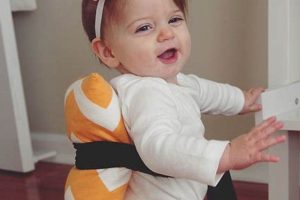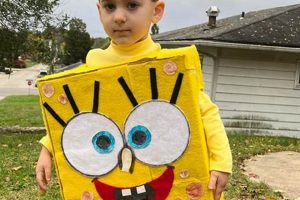Creating a homemade mummy outfit specifically tailored for women involves crafting a unique and personalized Halloween or costume party ensemble. This typically entails utilizing readily available materials to simulate the appearance of ancient Egyptian mummification wrappings, adjusted for a comfortable and aesthetically pleasing fit. For example, strips of fabric, tea-stained to achieve an aged effect, can be strategically layered and secured onto clothing to mimic the distinctive bandaged look.
Constructing such a costume offers several advantages. It allows for cost-effective creativity, enabling wearers to express individual style preferences through variations in fabric type, color, and wrapping techniques. Historically, the image of the mummy has been a popular and enduring figure in horror and popular culture, making it a recognizable and easily adaptable costume choice. Furthermore, a self-made garment offers the opportunity for adjustments to ensure both comfort and a flattering silhouette, addressing concerns about fit and movement often associated with commercially produced costumes.
The following sections will detail specific methods for preparing fabric, assembling the costume base, and applying wrapping techniques, along with suggestions for completing the overall look with makeup and accessories.
Expert Advice for a Self-Made Mummy Outfit
Achieving a convincing and durable mummy costume requires careful planning and execution. The following tips provide guidance for crafting a high-quality, visually appealing, and comfortable outfit.
Tip 1: Fabric Selection is Crucial. Opt for natural fabrics such as cotton or linen. These materials are breathable, readily available, and accept dyes well for creating an aged or distressed appearance.
Tip 2: Prioritize Comfort. The base garment should be comfortable and allow for ease of movement. Consider using leggings and a long-sleeved shirt as the foundation, ensuring a snug but not restrictive fit.
Tip 3: Tea-Staining Enhances Authenticity. Soaking fabric strips in tea or coffee creates a convincingly aged and weathered effect. Experiment with different concentrations and soaking times to achieve the desired hue.
Tip 4: Secure Wrapping Techniques are Essential. Utilize fabric glue or discreet stitching to attach the fabric strips to the base garment. Overlapping the strips strategically will create a layered and realistic bandaged appearance.
Tip 5: Strategic Tearing Adds Detail. Deliberately tearing fabric strips before or after application enhances the realism of the mummy costume. Vary the size and placement of tears for a more authentic effect.
Tip 6: Consider Mobility. Avoid wrapping the legs too tightly to maintain freedom of movement. Focus on securing the wrappings around the torso and arms, allowing for a more natural gait.
Tip 7: Makeup Completes the Transformation. Utilize pale foundation, dark eyeshadow, and subtle contouring to create a gaunt and undead appearance. Consider using dark eyeliner to emphasize the eyes.
Adhering to these guidelines will result in a mummy costume that is both visually striking and comfortable to wear. Attention to detail and careful execution are key to achieving a professional-looking result.
The concluding section will address safety considerations and provide suggestions for storage and maintenance of the completed mummy costume.
1. Fabric choice
Fabric choice represents a foundational element in the creation of a homemade mummy costume for women. The selected material directly influences the costume’s aesthetic appeal, comfort during wear, and overall durability. Natural fabrics, such as cotton or linen, are frequently preferred due to their breathability and ability to accept dyes effectively. These properties enable the creation of a convincingly aged appearance through techniques like tea staining. The texture of the fabric also contributes to the visual effect; a loosely woven material will create a more ragged and decayed look, whereas a tighter weave will provide a cleaner, more controlled aesthetic.
The selection of fabric directly impacts the costume’s comfort. Synthetic materials, while potentially more durable, can restrict airflow, leading to discomfort, especially during extended wear or in warmer environments. Cotton and linen, by contrast, allow for better ventilation, reducing the likelihood of overheating. Furthermore, the weight of the fabric affects mobility; lighter materials allow for greater ease of movement, while heavier fabrics may restrict movement and contribute to fatigue. For example, using a lightweight muslin provides a comfortable base, while layering heavier linen strips creates visual depth without excessive weight.
In summary, fabric choice is a critical decision point in the construction of an effective mummy costume. The ideal selection balances aesthetic considerations with practical needs, prioritizing breathability, comfort, and visual authenticity. While various materials may be utilized, natural fabrics offer distinct advantages in achieving a believable and wearable result. Poor material selection may result in a costume that is uncomfortable, lacks visual appeal, or is prone to damage, highlighting the importance of careful consideration during the initial planning stages.
2. Wrapping technique
The wrapping technique constitutes a central element in the successful creation of a do-it-yourself mummy costume tailored for women. The method by which fabric strips are applied to the base garment dictates the visual realism and overall effectiveness of the costume. Inadequate wrapping can result in a disorganized, unconvincing appearance, while a well-executed technique contributes significantly to the illusion of authentic mummification wrappings. For example, haphazardly applied strips may appear as mere fabric scraps, failing to convey the intended aged and layered effect. Conversely, carefully overlapping and securing fabric strips creates a convincing facsimile of historical bandaging practices.
Specific wrapping techniques offer varying degrees of realism and practicality. A simple method involves gluing or stitching strips directly onto the base garment in a crisscross pattern. A more advanced technique incorporates layering and varying strip widths to simulate the unevenness of ancient wrappings. The strategic use of adhesive bandages or medical tape underneath the fabric strips can enhance the texture and add a sense of decay. Furthermore, the tightness of the wrapping influences mobility. Overly constrictive wrapping can impede movement, while loosely applied strips may detach during wear. Therefore, a balance between visual appeal and functional wearability is essential.
In summary, the wrapping technique is not merely a superficial detail but rather a critical determinant of the overall success of a homema
de mummy costume. The selection of an appropriate technique, coupled with careful execution, directly impacts the costume’s aesthetic quality and wearer comfort. Challenges include achieving a balance between visual realism and ease of movement, as well as ensuring the durability of the wrappings throughout the duration of wear. Mastering the wrapping technique is paramount to achieving a convincingly authentic and wearable mummy costume.
3. Base garment
The base garment serves as the foundational layer upon which a homemade mummy costume is constructed. Its selection significantly influences comfort, fit, and the overall aesthetic success of the completed costume. Careful consideration of the base garment is therefore essential for achieving a desirable outcome.
- Material Composition and Comfort
The base garment’s material composition directly impacts wearer comfort. Natural fibers, such as cotton or linen, offer superior breathability compared to synthetic alternatives like polyester or nylon. A breathable base garment prevents overheating and minimizes discomfort during prolonged wear, particularly in indoor environments. For example, choosing a cotton long-sleeved shirt and leggings set provides a comfortable and absorbent foundation for layering fabric strips.
- Fit and Silhouette
The fit of the base garment dictates the overall silhouette of the costume. A close-fitting base, such as leggings and a form-fitting top, allows for a streamlined and anatomically accurate mummy appearance. Conversely, a loose-fitting base may result in a bulky and less defined silhouette. The color of the base garment should ideally complement or match the color of the fabric strips to create a seamless and cohesive look. A black or dark gray base can effectively mask any gaps between the wrappings.
- Durability and Support
The base garment provides structural support for the applied wrappings. A durable base garment, constructed from tightly woven fabric, can withstand the weight and tension of multiple layers of fabric strips. Reinforced seams and a well-constructed design prevent tearing or stretching during wear. The base garment also serves as an anchor point for securing the fabric strips, ensuring that the wrappings remain in place throughout the event. Without a sturdy base, the wrappings may shift, sag, or detach, compromising the costume’s integrity.
- Modifications and Adaptability
The base garment can be strategically modified to enhance the mummy costume’s visual impact. Rips, tears, and distressing can be incorporated into the base garment to simulate the decay and degradation associated with mummification. Padding can be added to certain areas, such as the shoulders or chest, to create a more pronounced or stylized silhouette. The base garment can also be layered with additional undergarments to provide warmth in colder climates or to further customize the fit and shape of the costume. For example, adding a thin thermal layer underneath the base garment provides insulation without adding bulk.
In conclusion, the base garment is a critical component of a do-it-yourself mummy costume. Its selection and modification directly influence the costume’s comfort, fit, durability, and overall aesthetic appeal. Careful consideration of these factors ensures a successful and visually compelling outcome, transforming a simple base into an integral element of the mummified persona.
4. Distressing effect
The distressing effect is integral to achieving a credible do-it-yourself mummy costume for women. This effect involves intentionally creating the appearance of age, wear, and decay on the costume’s fabric components. Cause and effect are demonstrably linked: the application of distressing techniques directly results in a more realistic and visually compelling mummy aesthetic, moving beyond a merely bandaged appearance toward one suggesting centuries of entombment. The importance of this effect lies in its capacity to transform simple fabric strips into elements suggesting historical authenticity and degradation. For instance, clean, white fabric evokes a modern bandage, while tea-stained and torn fabric evokes an ancient burial shroud. This transformation is critical in conveying the intended character portrayal.
Practical application of the distressing effect can be achieved through various methods. Tea staining, as previously noted, imparts an aged hue. Sandpapering and controlled tearing create realistic fabric fraying. The selective application of dark brown or black acrylic paint can simulate dirt and decomposition. The degree of distressing should be carefully calibrated to avoid undermining the structural integrity of the costume. Excessive tearing can lead to fabric disintegration, while over-application of paint can create an unconvincing, muddy texture. Achieving a balance between realism and durability requires experimentation and attention to detail. A real-life example would be comparing a professionally made mummy costume versus a poorly-made one. A profession costume would feature multiple layers of fabric, each distressed in a different way to simulate the effects of time on the different layers of the wrap. A poorly made costume would feature a single layer of fabric, hastily torn, and unevenly stained, which gives off the impression of a halloween costume, not the intended ‘mummy’ effect.
In summary, the distressing effect is not merely an aesthetic enhancement, but a fundamental component in the creation of a convincing mummy costume. It is a key distinguisher between a generic costume and a character portrayal rooted in visual authenticity. Challenges include achieving a balance between realism and durability, and avoiding over-application of distressing techniques. Effective integration of the distressing effect transforms basic materials into elements that convincingly evoke the passage of time and the historical context of the mummy figure, making it one of the most important parts of a “diy mummy costume womens”.
5. Comfort level
Comfort level represents a critical, yet often overlooked, element in the successful execution of a homemade mummy costume tailored for women. While visual authenticity is paramount, the practical implications of extended wear necessitate a focus on comfort to ensure a positive experience. The relationship between comfort and costume design is directly proportional: as comfort decreases, the wearer’s enjoyment and ability to fully embody the character diminishes. The importance of comfort as a component of such a costume stems from the often restrictive nature of the design; multiple layers of fabric, potential tightness around the body, and limitations in mobility can quickly lead to discomfort if not properly addressed during the construction process. A real-life example would be a costume that looks visually impressive but is so restrictive that the wearer can barely sit, dance, or move freely, thus detracting from the overall experience. This constraint renders the costume impractical for social events, effectively negating its intended purpose.
The practical significance of understanding the impact of comfort extends to the sele
ction of materials and construction techniques. Prioritizing breathable fabrics, such as cotton or linen, allows for better air circulation, reducing the risk of overheating. Designing the costume with strategically placed openings or slits can improve range of motion and prevent feelings of confinement. Adjustable closures, such as Velcro or elastic bands, provide flexibility in fit and accommodate varying body shapes. Moreover, careful attention to the weight distribution of the costume can minimize strain on specific areas, such as the shoulders or neck. For example, securing heavier fabric layers to a supportive undergarment can alleviate pressure and improve overall comfort.
In summary, comfort level is not a secondary consideration but an intrinsic aspect of a well-designed mummy costume. It directly influences the wearer’s enjoyment, mobility, and ability to fully engage in costume-related activities. Overlooking comfort can lead to a visually impressive but ultimately impractical and unenjoyable costume. Addressing comfort concerns through strategic material selection, design modifications, and construction techniques ensures a successful outcome, transforming a potentially restrictive garment into a wearable and engaging piece of costumery, and completing what makes a “diy mummy costume womens” great!
Frequently Asked Questions Regarding DIY Mummy Costumes for Women
This section addresses common inquiries and concerns related to constructing a do-it-yourself mummy costume specifically designed for women. The following questions and answers provide practical guidance and clarification on key aspects of the costume-making process.
Question 1: What fabrics are most suitable for creating a realistic and comfortable mummy costume?
Natural fabrics such as cotton and linen are recommended due to their breathability and ability to accept dyes effectively. These materials offer superior comfort during extended wear compared to synthetic alternatives. Furthermore, their texture lends itself well to creating a weathered and aged appearance.
Question 2: How can the fabric be distressed to achieve an authentic, aged look?
Distressing techniques include tea or coffee staining, sandpapering, controlled tearing, and the strategic application of dark-colored acrylic paint. These methods simulate the effects of time and degradation, enhancing the costume’s visual realism. Excessive distressing should be avoided to prevent structural damage to the fabric.
Question 3: What is the best approach for wrapping the fabric strips to achieve a convincing mummy appearance?
Overlapping and layering fabric strips is essential. Fabric glue or discreet stitching secures the wrappings to the base garment. Varying the width and angle of the strips creates a more natural and uneven appearance. Consider leaving some areas intentionally exposed to reveal underlying layers or simulate decay.
Question 4: What type of base garment is recommended for a DIY mummy costume?
A close-fitting, long-sleeved shirt and leggings set made from breathable fabric, such as cotton, is generally preferred. The base garment provides a comfortable and supportive foundation for the wrappings. The color of the base should complement or match the color of the fabric strips.
Question 5: How can mobility be maintained while still achieving a visually authentic mummy costume?
Avoid wrapping the legs too tightly to allow for ease of movement. Focus on securing the wrappings around the torso and arms, leaving sufficient freedom for walking and bending. Elastic or adjustable closures can be incorporated to accommodate varying body shapes and sizes.
Question 6: What safety precautions should be taken when creating and wearing a DIY mummy costume?
Ensure that the fabric strips are securely attached to prevent tripping hazards. Avoid using flammable materials or exposing the costume to open flames. Consider visibility when selecting fabric colors and accessories. If using adhesives, ensure adequate ventilation. Test all materials for skin sensitivity before prolonged wear.
In summary, careful planning, material selection, and execution are crucial for constructing a successful do-it-yourself mummy costume. Prioritizing comfort, safety, and visual realism ensures a positive and engaging experience.
The concluding section will offer tips for storing and maintaining a self-made mummy costume to prolong its life and utility.
Conclusion
The exploration of diy mummy costume womens has encompassed critical elements from fabric selection and distressing techniques to wrapping methods and comfort considerations. The process demands a balance between visual fidelity and practical wearability. A well-executed homemade mummy costume requires careful planning and attention to detail, emphasizing both aesthetic appeal and the wearer’s experience. A successful construction demonstrates resourcefulness and ingenuity in recreating a classic, culturally resonant figure.
The enduring appeal of the mummy motif provides ample opportunity for creative expression and personal adaptation. Continued refinement of construction techniques and material choices will further enhance the quality and accessibility of these costumes. This continued exploration offers the potential to elevate a simple costume into a distinct and individualized artistic statement.







